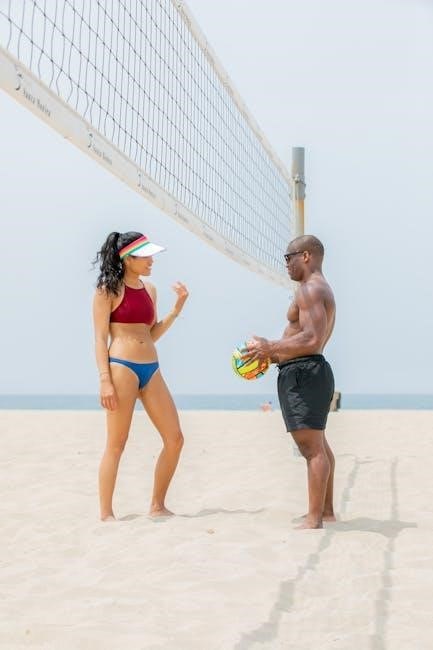
The FIVB Volleyball Rules govern both indoor and beach volleyball, ensuring fair play and standardization globally. Recent updates from the 39th FIVB World Congress in 2024 emphasize rule clarity and player safety, with official rulebooks for 2025-2028 now available, providing detailed guidelines for players, referees, and fans worldwide.
1.1 Indoor Volleyball Rules
Indoor volleyball rules, governed by the FIVB, outline the framework for competitive play. A match is played between two teams of six players each, with a maximum of three substitutions per set. The court measures 18×9 meters, divided by a net 2.43 meters high for men and 2.24 meters for women. Points are scored when a team fails to return the ball or commits a fault. The double contact violation, recently reinterpreted, penalizes players for controlling the ball twice in succession, except for the first touch. Official rulebooks for 2015-2016 and 2025-2028 are available, ensuring clarity and consistency in gameplay. These rules are essential for players, referees, and fans to understand the sport fully.
1.2 Beach Volleyball Rules
Beach volleyball rules, governed by the FIVB, emphasize fast-paced gameplay on sand courts. Teams consist of two players per side, with substitutions allowed only through official procedures. The scoring system mirrors indoor volleyball, with sets played to 21 points and a minimum two-point lead required to win. Recent updates in the 2025-2028 rulebook clarify double contact violations, particularly for setters, ensuring consistency in enforcement. The smaller court size and absence of block counts distinguish beach volleyball from its indoor counterpart. Let serves are permitted, and players must avoid touching the net during play. Official rulebooks, available on the FIVB website, provide detailed guidelines for competitors and referees, ensuring fair and standardized gameplay worldwide.
Understanding the Game Characteristics
Volleyball’s dynamic nature includes fast-paced rallies, strategic teamwork, and precise rules. Recent rule changes, like reinterpretations of the double contact violation, aim to enhance fairness and player safety.
2.1 Number of Players
In volleyball, each team consists of six players on the court and up to six substitutes. The standard format applies to both indoor and beach volleyball, with teams alternating turns. The libero, a defensive specialist, is a unique position with specific rules. Substitutions are limited to six per set, ensuring strategic player rotation. Recent FIVB updates clarify player roles and substitutions, maintaining fair play. Official rulebooks for 2025-2028 detail these guidelines, emphasizing team composition and player participation. This structure ensures balanced gameplay and clear expectations for all players and teams competing under FIVB regulations.
2.2 Game Duration
A volleyball match is typically played as a best-of-five sets, with each set won by the first team to reach 25 points with a two-point advantage. If the score is tied at 24-24, play continues until one team leads by two points. The duration of a match can vary, but it generally lasts between 60 to 90 minutes, depending on the intensity and number of sets played. Official FIVB rules specify that each set has a 25-point target, ensuring a balanced and competitive structure. The game’s time frame is designed to maintain player stamina while keeping the pace dynamic for spectators.
2.3 Scoring System
In volleyball, points are scored when a team wins a rally, regardless of which team served. A match is typically played as best two out of three sets. Each set is played to 25 points, with a minimum lead of two points required to win. If the score reaches 24-24, play continues until one team leads by two points. The scoring system emphasizes precision and strategy, with teams earning points through opponent errors or successful attacks. Recent FIVB updates clarify scoring rules, ensuring consistency across indoor and beach volleyball. Official rulebooks for 2025-2028 detail these guidelines, providing clear frameworks for players and referees worldwide.
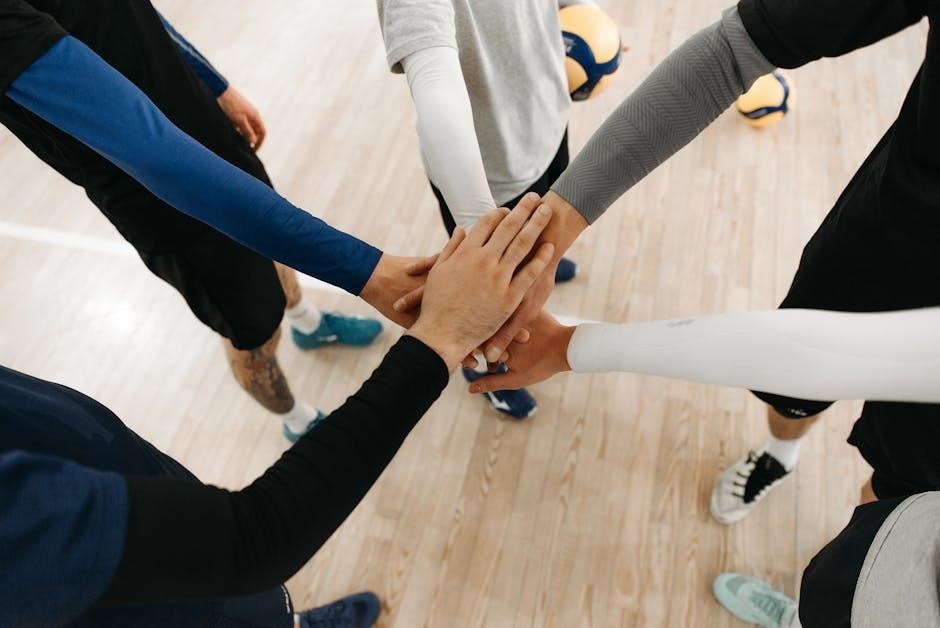
Player and Team Regulations
The FIVB’s updated rulebooks for 2025-2028 outline team composition, player positions, and legal plays, emphasizing adherence to regulations and proper conduct during matches.
3.1 Player Positions
In volleyball, each team has six players on the court, each with distinct roles. The Setter orchestrates the offense, while Outside Hitters and Opposite Hitters score points through attacks. Middle Blockers focus on blocking and quick attacks, and the Libero specializes in defense and passing, wearing a different-colored jersey. Players must align correctly at the start of each play, with the Libero restricted from blocking or attacking. These positions ensure balanced gameplay, with each role contributing uniquely to team success. The FIVB rules emphasize positional discipline to maintain fair and dynamic competition.
3.2 Substitutions
In volleyball, substitutions are a crucial aspect of team strategy. According to the FIVB rules, each team is allowed up to six substitutions per set in indoor volleyball. Substitutions must be requested by the captain and approved by the referee. Players entering the game must do so through the designated substitution zone and replace the exiting player. The libero, a defensive specialist, has specific substitution rules and can be replaced unlimited times but only through the substitution zone. Proper substitution procedures ensure fair play and maintain the flow of the game. Misconduct or unauthorized substitutions can result in penalties, emphasizing the importance of adhering to these regulations.
3.3 Team Composition
A volleyball team consists of 6 players on the court and up to 6 substitutes. Indoor teams must have a libero, a defensive specialist who wears a different jersey and cannot block or attack. Beach volleyball teams have 2 players per side, with no substitutions allowed during the match. Teams must adhere to FIVB rules regarding player roles and substitutions to maintain fair play. The official rulebooks for 2025-2028 outline these compositions in detail, ensuring clarity for players and referees. Proper team composition is essential for maintaining the integrity and flow of the game, as specified in the latest updates from the FIVB World Congress.

Roles of Officials

Referees, scorekeepers, and other officials ensure fair play and enforce rules during matches. Their roles include managing game flow, tracking scores, and making accurate decisions to maintain game integrity.
4.1 Referees
Referees play a crucial role in ensuring fair play and adherence to FIVB Volleyball Rules. They are responsible for enforcing rule compliance, managing game flow, and making decisions on faults. Referees undergo rigorous training, including refresher courses, to stay updated on rule interpretations. Their decisions are final, and they must remain impartial to maintain the integrity of the game. With the recent updates to the 2025-2028 rules, referees are now more focused on clarifying ambiguities, such as the double contact violation, to provide consistent judgments. Their expertise ensures that matches are conducted smoothly, respecting both the rules and the spirit of the game.
4.2 Scorekeepers
Scorekeepers play a crucial role in volleyball by accurately recording game statistics and scores. They ensure the official score sheet is updated in real-time, reflecting points, substitutions, and timeouts. The scorekeeper collaborates with referees to confirm decisions and maintain game flow. According to the Official Volleyball Rules 2025-2028, their duties include tracking serve patterns, attack attempts, and blocking efficiency. They also manage player rotations and substitutions, ensuring compliance with regulations. The scorekeeper’s precision is vital for fair play and post-match analysis. Their work is guided by FIVB rulebooks, which outline detailed procedures for scoring and data collection during matches.
4.3 Other Officials
Besides referees and scorekeepers, other officials play crucial roles in ensuring smooth gameplay. Line judges are responsible for monitoring the sidelines and end lines, signaling when the ball lands outside the court. Technical delegates oversee the overall competition, managing logistics and equipment. Statisticians record detailed match data, tracking player performance and team strategies. Additionally, a court supervisor may be present to assist referees and manage substitutions. These officials work together to maintain fairness and efficiency, adhering to FIVB rules. Their contributions are vital for accurate scoring, rule enforcement, and providing valuable insights for teams and spectators alike. Their roles are outlined in the official FIVB rulebooks for 2025-2028.
Gameplay Rules
Volleyball gameplay involves serving, rallies, attacks, blocking, and digging. The FIVB updates clarify rules like double contact violations, ensuring fair play and smooth game flow for all players.
5.1 Serving
Serving is the initial action to start a rally in volleyball. A serve can be underhand or overhand, with the ball tossed and struck before crossing the net. The server must stay behind the back line of the court until contact. The ball must clear the net and land within the opponent’s court for a valid serve. Let serves, where the ball touches the net but still lands in the opponent’s court, are allowed. A serve resulting in a fault, such as landing outside the court or failing to clear the net, awards the opposing team a point. Recent rule updates emphasize strict adherence to foot positioning and ball contact regulations to maintain fairness and consistency in gameplay.
5.2 Rallies
A rally in volleyball is a sequence of plays where both teams hit the ball back and forth over the net until a team fails to return it or makes a fault. The rally begins with a serve and continues until a point is scored. Teams are allowed up to three touches to return the ball, with the libero restricted from attacking. Recent FIVB rule updates clarify that a rally ends immediately if a fault occurs, such as a net violation or double contact. These rules ensure fair play and maintain the dynamic flow of the game, emphasizing precise teamwork and skill. Proper officiating is crucial to enforce these guidelines effectively.
5.3 Attacks
An attack in volleyball is an action where a player attempts to hit the ball to make it land on the opponent’s side. According to the FIVB Volleyball Rules, an attack hit is counted as one of the three allowed touches per team. Players can use various techniques such as spikes, tips, or rolls to execute an attack. A key rule is that attackers must not reach over the net or interfere with opponents. Recent updates emphasize fair play, ensuring attackers do not illegally cross the net or make unnecessary contact. Proper footwork and body positioning are crucial to avoid violations. Official rulebooks for 2025-2028 provide detailed guidelines on legal attacking techniques and prohibited actions, ensuring clarity for players and referees alike.
5.4 Blocking
Blocking is a defensive action where players at the net attempt to stop the opponent’s attack by reaching above the net and deflecting the ball. According to FIVB rules, a block is counted as one of the three allowed touches per team. Only front-row players can perform blocks, and they must not touch the ball beyond the net or interfere with the opponent’s play. Recent rule updates emphasize fair play, ensuring blockers do not illegally cross the net or make unnecessary contact. Proper hand positioning and timing are crucial to avoid violations. Blocking is a strategic element in volleyball, requiring coordination and precision to execute effectively.
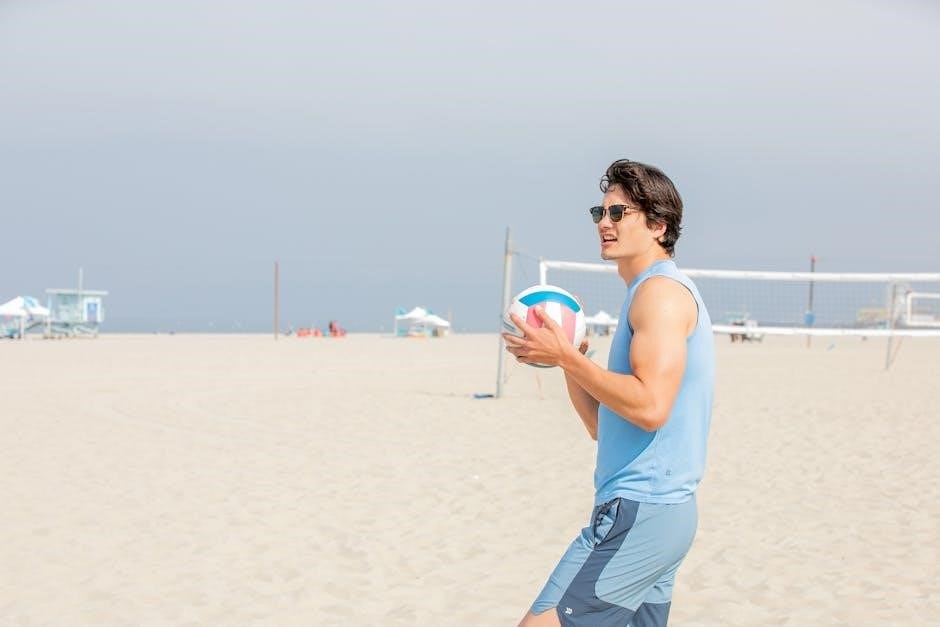
5.5 Digging
Digging is a defensive action where a player prevents the ball from touching the ground after an attack. It requires precise timing and positioning. According to FIVB rules, a dig is legal as long as the ball is contacted cleanly and not held or lifted. Recent updates emphasize the importance of distinguishing digs from lifts, ensuring referees penalize illegal actions. Proper digging techniques, such as rolling or sliding, are highlighted in training materials to avoid injuries. The 2025-2028 rulebook clarifies that a dig is one of the first contact options, crucial for maintaining rallies. Officials are trained to recognize valid digs, ensuring fair play and exciting gameplay.
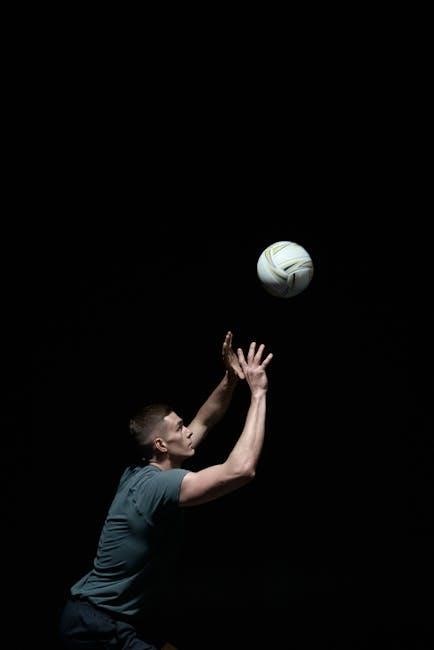
Violations and Faults
Violations include faults like double contact, net violations, and lifting. The FIVB is reinterpreting the double contact rule, focusing on setters touching the ball more than once.
6.1 Types of Faults
In volleyball, faults are rule violations that result in a point for the opposing team. Common types include double contact, where a player touches the ball twice in a row without losing possession, and net violations, such as reaching over the net or touching it during play. Lifting or carrying the ball, where it is held or thrown, is also a fault. Additionally, over-the-net interference occurs when a player interferes with the opponent’s play across the net. These faults are crucial for maintaining fair play and are outlined in the official FIVB rulebooks for both indoor and beach volleyball, ensuring consistency across all levels of competition.
6.2 Double Contact Violation
A double contact violation occurs when a player touches the ball twice consecutively or makes contact with it more than once before it crosses the net. This rule applies to all players, with particular attention on setters, who often handle the ball. The FIVB is considering a global re-interpretation of this rule to clarify when multiple contacts are legal, such as during a single attempt to play the ball. Recent discussions aim to modernize the rule while maintaining fair play. Official rulebooks for 2025-2028 detail these guidelines, ensuring consistency across indoor and beach volleyball. Referees are trained to enforce this rule strictly to uphold the integrity of the game.
6.3 Net Violations
A net violation occurs when a player interferes with the net during play. This includes touching the net with any part of the body or reaching over it to interfere with the ball. According to the official FIVB Volleyball Rules, such actions are considered faults, resulting in a point for the opposing team. The rules emphasize maintaining the integrity of the net as a critical element of fair play. Players must avoid any contact that could influence the ball’s trajectory or disrupt the opponent’s play. Referees closely monitor these interactions to ensure adherence to the rules. Updates in the 2025-2028 rulebook clarify these violations, ensuring consistency across all matches.
6.4 Lifting or Carrying
Lifting or carrying the ball is a violation in volleyball where a player holds or throws the ball instead of making a legal contact. This fault occurs when the ball is not rebounded or hit, but rather caught or carried, often by setters or liberos. The FIVB rules emphasize that the ball must be contacted, not held, to maintain the integrity of the game. If a player is found lifting or carrying the ball, the opposing team is awarded a point. This rule ensures the game remains dynamic and fair, preventing players from gaining an unfair advantage through illegal ball handling.
6.5 Over-the-Net Interference
Over-the-net interference occurs when a player interferes with the ball or an opponent over the net, violating volleyball rules. This includes reaching over the net to block or attack the ball before it lands on the opponent’s side. The penalty results in a point for the opposing team. Recent FIVB updates clarify that incidental contact with the net by a player not interfering with the ball is not considered a fault. Referees closely monitor such actions to ensure fair play and maintain game integrity. Understanding this rule is crucial for players to avoid unnecessary penalties and compete within legal boundaries.
Special Situations
Special situations include time-outs, injuries, and misconduct, governed by FIVB rules to ensure fair play. Recent updates from the 2024 Congress clarify procedures for these scenarios, enhancing gameplay integrity and player safety, as detailed in the 2025-2028 rulebook.
7.1 Time-Outs
In volleyball, time-outs are strategic pauses teams can take to regroup and plan. According to the FIVB rules, each team is allowed a limited number of time-outs per set, typically two, each lasting 30 seconds. Time-outs can be requested by the captain or coach and must be approved by the referee. Teams often use this break to discuss tactics, motivate players, or adjust strategies. The referee signals the end of the time-out, resuming play with a serve. Recent updates from the 39th FIVB World Congress in 2024 emphasize strict adherence to time-out durations to maintain game flow. Proper use of time-outs is crucial for optimizing performance and maintaining competitive balance.
7.2 Injuries
In volleyball, injuries are addressed with specific protocols to ensure player safety and fair play. If a player is injured during a match, the referee may stop the game to allow medical assistance. Teams are permitted to substitute an injured player, but this must be approved by the referee. The injured player may not return to the game until authorized by medical staff. Recent updates emphasize the importance of proper injury management to prevent further harm. Officials are trained to handle such situations efficiently, balancing player well-being with game continuity. These rules are detailed in the official FIVB Volleyball Rules 2025-2028, ensuring consistency across all competitions.
7.3 Misconduct
Misconduct in volleyball refers to unsportsmanlike behavior by players, coaches, or team officials. This includes actions like verbal abuse, gestures, or deliberate attempts to disrupt the game. According to the Official Volleyball Rules, misconduct can result in penalties such as warnings, time-outs, or even disqualification. Repeat offenses may lead to more severe consequences, including expulsion from the match. Referees are authorized to address misconduct promptly to maintain fair play and respect among all participants. The FIVB emphasizes the importance of sportsmanship and adherence to these rules to ensure a positive and competitive environment for everyone involved. Proper conduct is essential for the integrity of the game.
Recent Rule Changes
The FIVB has introduced updates to the double contact violation, particularly affecting setters, aiming to clarify ambiguous situations and ensure consistent enforcement across all competitions globally.
8.1 Updates from FIVB
The FIVB has introduced significant updates to volleyball rules for 2025-2028, focusing on enhancing gameplay clarity and player safety. A key change involves the reinterpretation of the double contact violation, particularly affecting setters, to ensure consistency in enforcement. Additionally, the new rules aim to streamline scoring systems and reduce stoppages in play. The 39th FIVB World Congress in 2024 approved these changes, which are detailed in the official rulebooks published in 2025. These updates reflect FIVB’s commitment to modernizing the sport while maintaining its core traditions. The revised rules are now available online, providing players, referees, and fans with clear guidelines for the upcoming competitions.
8.2 Impact on Gameplay
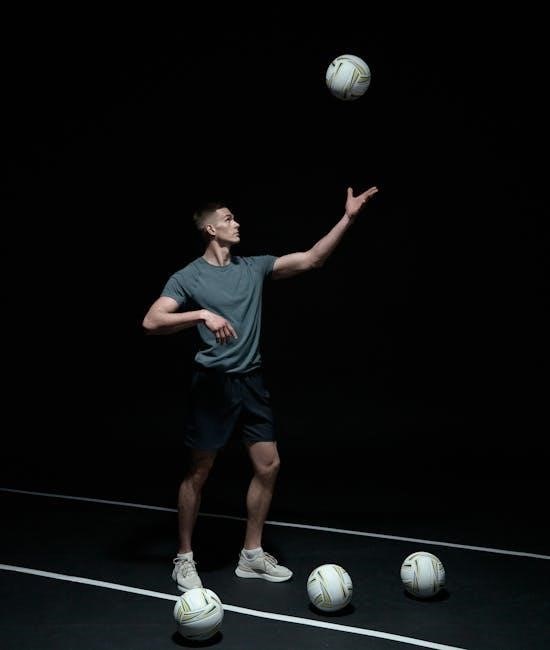
Recent rule changes by the FIVB, outlined in the 2025-2028 official rulebook, aim to enhance gameplay dynamics and player safety. The reinterpretation of the double contact violation, particularly for setters, reduces confusion and promotes fair play. These updates encourage a faster-paced game, emphasizing skill and strategy. Referees, after undergoing refresher courses, enforce rules more consistently, ensuring a balanced competitive environment. The adjustments also clarify over-the-net interference and lifting violations, providing clearer guidelines for players and officials. Overall, these changes contribute to a more thrilling and equitable sport, aligning with the FIVB’s commitment to modernizing volleyball while preserving its core essence.

Resources and Further Reading
Official Volleyball Rules 2025-2028 and training materials are available on the FIVB website. Online courses and refresher programs for referees are also accessible for deeper understanding.
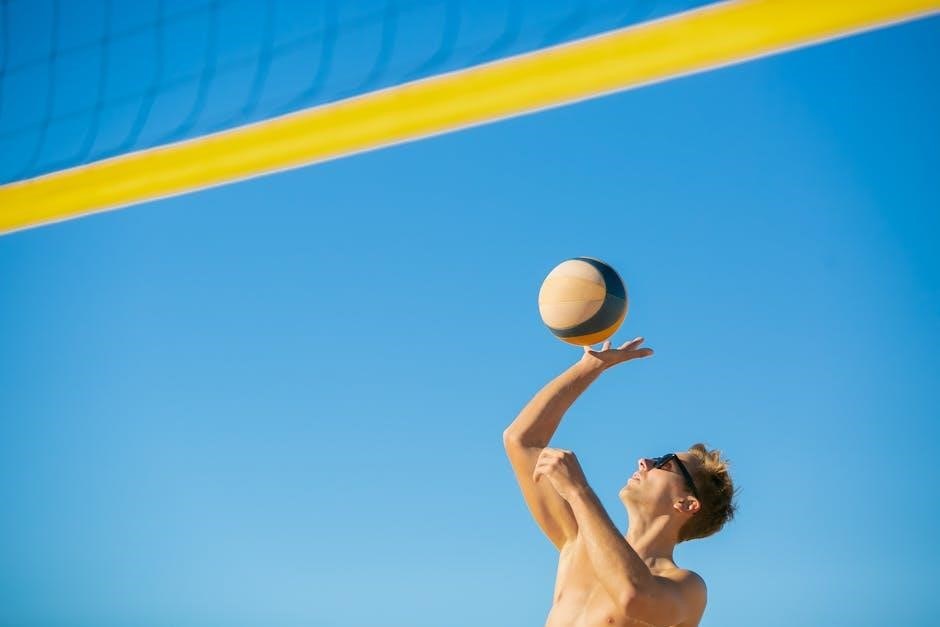
9.1 Official Rulebooks
The FIVB publishes official rulebooks for both indoor and beach volleyball, available in PDF format on their website. These rulebooks, such as the 2025-2028 editions, are approved by the FIVB World Congress and provide detailed guidelines for players, referees, and coaches. They cover all aspects of the game, including gameplay rules, violations, and official procedures. The rulebooks are essential for understanding the sport’s regulations and ensuring consistency across all levels of competition. Design and layout are managed by the FIVB, with illustrations and content updated regularly to reflect the latest rule changes. These documents are a vital resource for anyone involved in volleyball, from professional leagues to grassroots development programs.
9.2 Training Materials
Official FIVB training materials, including manuals and guides, are essential for understanding volleyball rules. These resources cover game characteristics, rule updates, and practical applications for players and referees. The 2025-2028 rulebook, published by FIVB, provides detailed insights into recent changes, while online courses offer interactive learning. Refresher courses, like the five-day program for referees, ensure officials are up-to-date. Additionally, YouTube offers tips for customizing learning experiences, such as organizing playlists and optimizing content. These materials are designed to enhance knowledge and skills, ensuring consistency in gameplay and officiating. They are accessible through the FIVB website and other official platforms, making them a valuable tool for all volleyball enthusiasts.

9.3 Online Courses
Online courses offer comprehensive training on FIVB volleyball rules, providing in-depth insights for players, coaches, and referees. Platforms like YouTube and official FIVB websites host tutorials, webinars, and interactive sessions. These resources cover rule updates, such as the 2025-2028 guidelines, and practical applications. Courses often include video demonstrations, quizzes, and downloadable materials, ensuring learners grasp key concepts. Referees and players benefit from real-game scenarios and expert analysis. The convenience of online learning allows participants to study at their own pace, enhancing their understanding of volleyball rules and improving gameplay. These courses are essential for staying updated on the latest regulations and mastering the sport.
Conclusion
The FIVB Volleyball Rules are continually evolving to enhance gameplay and ensure fairness. Recent updates, such as the reinterpretation of the double contact violation, reflect the federation’s commitment to improving the sport. Official rulebooks for 2025-2028 provide clarity and consistency, while training materials and online courses offer resources for players and referees. These changes aim to promote player safety and maintain the integrity of the game. By staying informed about the latest regulations, participants can fully engage with volleyball’s dynamic and competitive nature. The FIVB’s efforts ensure that volleyball remains a global sport, accessible and enjoyable for all.


